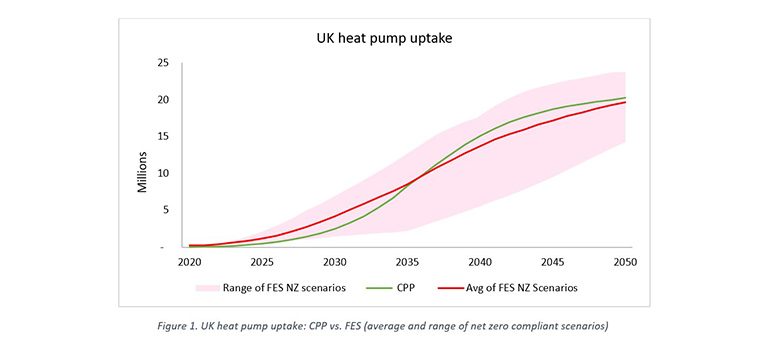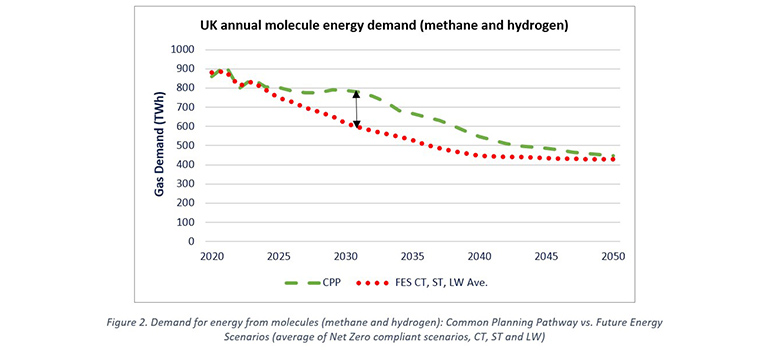System inertia undermines the near-term pace of decarbonization
How will a clear whole energy system view help the industry to understand the peak demands that each energy asset will experience? Obtain insights from DNV’s Common Planning Pathway Project.
The UK has a legally binding target to reach net zero carbon dioxide emissions by 2050.
However, DNV's UK Energy Transition Outlook (ETO) shows that the UK will not achieve this target on its current decarbonization path. At present, the UK does not have an agreed-upon route to net zero that seems plausible, considers the whole energy system and its value chain, and covers all energy vectors without an inherent bias.
DNV has developed a pathway that may be used as a tool to inform critical energy system infrastructure planning. The Common Planning Pathway (CPP) is intended to fill the gap for an agreed-upon pathway to net zero and represents a balanced cost-optimized net zero pathway to address the risks of energy security and resilience. The CPP is designed utilizing DNV’s UK ETO model and is built upon engagement with key stakeholders in the UK energy system.
The CPP methodology is forward-looking and considers the current state of the energy system. This distinguishes it from other planning tools that tend to work back from an end state (i.e., net zero) and follow a rather linear trajectory. This enables the CPP to capture the role of inertia in the energy system and determine the pace of the energy transition going forward — particularly in the short-term. Let’s illustrate system inertia with an analogy. If we think of the current level of carbon-emitting assets and equipment in the energy system as the level of water in a bathtub, this level can be changed by opening the tap (inflow) or opening the drain (outflow), but it can only change gradually — there is no way to instantly change the level of the water in the bathtub. A real-world parallel is the number of gas boilers in today’s homes — policy can accelerate the replacement of these, but system inertia means that decarbonization of household heating will inevitably take decades.
Figure 1 compares heat pump uptake in the CPP versus the Future Energy Scenarios (FES) 2022. The graph shows that in CPP uptake is initially slower than average of the FES net zero scenarios but gathers pace in the 2030s and converges towards the FES average by 2050. While the FES average curve looks fairly linear, the CPP curve is S-shaped. This S-shape is more aligned with historical examples of new technology adoption and the literature on diffusion of innovations (Rogers, 1995).

Today, heat pump uptake is only about 60,000 per year and, given the time it takes for the supply chain to expand and adapt, it is hard to imagine how this can reach over 500,000 by 2026 in the FES average curve. Our modelling shows that uptake in the short-term will be slower, reaching 300,000 new installations in 2026 (still highly ambitious but perhaps more plausible). As existing gas boilers reach the end of their life, heat pump technology improves, costs come down and supply chains are established, uptake will accelerate significantly in the 2030s and beyond.
In the same vein, the current energy system is largely made up of carbon emitting assets with long operational lifetimes. These assets include, at a system level, fossil fuel fired power stations and industrial emitters, and at a domestic level, gas boilers and internal combustion engine cars. Many of these assets are not due to be decommissioned or replaced in the coming years. While we are still installing new gas boilers, buying internal combustion engine cars, and maximizing the lifetime of gas fired power stations, the pace of the transition will be slow to begin with.
The effect of system inertia is stark. When compared to an average of the net zero Future Energy Scenarios, there is evidently an overall higher demand for molecules in the short to medium term, before the energy transition gathers pace post-2030, resulting in convergence of Common Planning Pathway and Future Energy Scenarios towards 2050.

Inertia is a property of the system, not an assumption that we have taken. It means that over the next 5-10 years, energy system developments will be largely dictated by present-day realities, but it does not mean that we still have time or that we can delay action by another 10 years, rather the contrary. The energy system is a large inert system that cannot transform overnight, as you cannot bring a train to a halt instantly. What the CPP shows is that, even with a highly ambitious package of policies, it will take about 5-10 years for these policies to come to fruition and for the energy system to start transforming at pace. Decisions taken now will only be felt in the 2030s.
An Implication of this is that, in the short to medium term, continued investment in the gas network is essential to maintain resilience and security of supply (versus any planning based on FES). At the same time, stronger decarbonization policies, including rapidly rising carbon prices, need to be in place swiftly, as otherwise the 2050 Net Zero target will be further out of reach because of inertia in the system.
Industry and policymakers should assess the outcomes of this analysis, in order to inform future policies and regulations. We encourage energy system planners, in both gas and electricity, to consider the risks of under-planning for infrastructure requirements in the short to medium term. Energy networks should consider the use of the Common Planning Pathway in any forward-looking studies to incorporate a broader range of possible futures to inform the scope, scale, and pace of network investments.
Watch an on-demand recording of our recent Common Planning Pathway webinar to learn how a clear whole energy system view will help the industry to understand the peak demands that each energy asset will experience.
9/7/2023 8:00:00 AM
